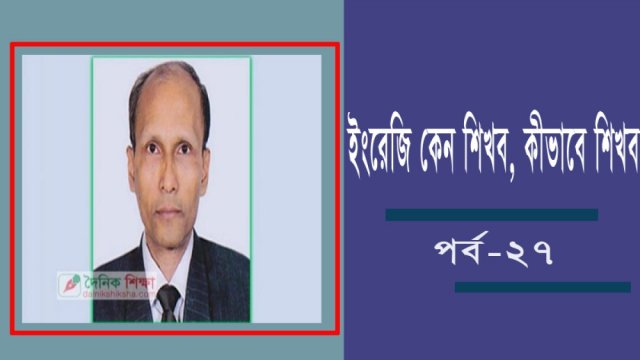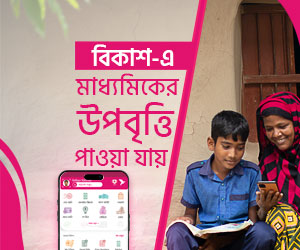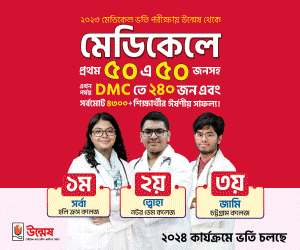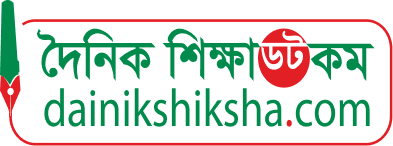Vocabulary
কীভাবে বাড়াবেন আপনার Vocabulary? ভাষা ব্যবহার করার ক্ষেত্রে Vocabulary এর ব্যবহার এবং বাড়ানোর মধ্যে গভীর সম্পর্ক রয়েছে। আপনি যদি শব্দই না জানেন তাহলে ভাষা ব্যবহার করবেন কীভাবে? ভাবের আদান-প্রদান বা কমিউনিকেশন করবেন কীভাবে? আজকে আমরা আলোচনা করব কিভাবে আমাদের Vocabulary বৃদ্ধি করব এবং একজন শিক্ষক ক্লাসে ছাত্রছাত্রীদের Vocabulary কীভাবে শেখাবেন। Vocabulary মানে আমরা বুঝি অনেকগুলো শব্দ জানা। আসলে Vocabulary মানে শুধুমাত্র শব্দ জানা নয়, বাক্যে শব্দের সঠিক ব্যবহার। অনেক শিক্ষক কিংবা অনেক অভিভাবক ছাত্রছাত্রীদের বলেন Vocabulary মুখস্থ করে ফেলতে। শুধু Vocabulary মুখস্থ করে ফেললে যে জ্ঞান অর্জিত হবে তা দিয়ে সঠিকভাবে ভাষা ব্যবহার করা যায় না। বাক্যে শব্দের সঠিক ব্যবহার দেখতে হবে, জানতে হবে এবং নিজে ব্যবহার করা শিখতে হবে। Vocabulary বৃদ্ধির কতকগুলো কৌশল এখানে উল্লেখ করা হলো।
মনে রাখবেন আপনি যে সব শব্দের শুধু জানেন কিন্তু শব্দগুলো ব্যবহার করেন না এই বিষয়টি passive vocabulary নামে পরিচিত। আর যে শব্দের আপনি অর্থও জানেন এবং ব্যবহারও জানেন সে বিষয়টি active vocabulary. আর আপনার দরকার active vocabulary, কারণ active vocabulary এর মাধ্যমেই আপনি communicate করবেন আপনার বাস্তব জীবনের প্রয়োজনীয় অনেক চাহিদা মেটানোর জন্য ।
ধরা যাক একজন শিক্ষক স্কুল সম্পর্কিত অনেক শব্দ ছাত্রছাত্রীদের শেখাবেন। এ ক্ষেত্রে তিনি ছাত্রছাত্রীদের গ্রুপ করে দিতে পারেন। প্রতিটি গ্রুপকে বলা হতে পারে, যে গ্রুপ যত বেশি ইংরেজি শব্দ দশ মিনিটের মধ্যে লিখতে পারবে সে গ্রুপ বিজয়ী হবে। এতে ছাত্রছাত্রীদের মধ্যে এক ধরনের প্রতিযোগিতা সৃষ্টি হবে এবং তারা দ্বিগুণ উৎসাহ নিয়ে কাজটি করবে। ছাত্রছাত্রীদের brain অত্যন্ত শার্প। বয়সের কারণে তারা এক কিংবা দু মিনিট কোনো ধরনের কাজ ছাড়া বসে থাকতে পারে না। শিক্ষক যদি তাদেরকে এ ধরনের সৃজনশীল কোনো কাজে না লাগান তাহলে দেখা যাবে তারা অন্য কোনো কাজ করে সময় নষ্ট করছে। কাজেই তাদেরকে কাজ দেয়ার পর ঘুরে ঘুরে দেখুন, প্রতিটি টেবিল বা বেঞ্চে যান, শিক্ষার্থীদের সাথে কথা বলুন। দশ মিনিট পরে তাদের খাতাগুলো সংগ্রহ করবেন। এরপর প্রতি গ্রুপ থেকে একজন করে প্রতিনিধি এসে তার গ্রুপের লিখিত শব্দগুলো পুরো ক্লাসকে পড়ে শোনাবে। এভাবে দেখা যাবে তিনটি বা চারটি গ্রুপের শব্দগুলোর মধ্যে অনেক common এবং কিছু uncommon শব্দ পাওয়া যাবে। uncommon শব্দগুলো সকল ছাত্রছাত্রীদের জন্য নতুন করে জানা হলো। এমন কিছু শব্দ যেগুলো কোনো শিক্ষার্থীই লিখতে পারেনি সেসব ক্ষেত্রে শিক্ষক নিজে বোর্ডে লিখে দিবেন এবং বলে দিবেন।
এবার শিক্ষক ছাত্রছাত্রীদেরকে উক্ত শব্দগুলো দিয়ে বাক্য তৈরি করতে বলবেন। এ কাজটিও একইভাবে গ্রুপে তৈরি করতে বলতে পারেন। নির্দিষ্ট সময় নির্ধারণ করে দেবেন। একইভাবে শিক্ষক সমস্ত ছাত্রছাত্রীদের খাতা সংগ্রহ করবেন এবং দ্বিতীয় অন্য একজনকে আহ্বান করবেন উপস্থাপনা করার জন্য। দেখা যাবে অনেক ছাত্রছাত্রীই ভুল বাক্য লিখবে, শিক্ষকের কাজ হবে ধমক না দিয়ে এবং নাম উল্লেখ না করে বাক্যগুলো শুদ্ধ করে দেয়া। শিক্ষক বলবেন বাক্যটি এভাবে লিখলে ভালো হবে। এরপর ছাত্রছাত্রীদেরকে শুদ্ধ বাক্যটি বা বাক্যগুলো পুনরায় লিখতে বলবেন। তাহলে দেখা যাবে ছাত্রছাত্রীদের স্কুল সম্পর্কিত paragraph বা essay আলাদভাবে মুখস্থ করতে হচ্ছে না। আর Vocabulary টিচিংয়ের এখানেই সার্থকতা। এভাবে বিভিন্ন বিষয় নিয়ে একজন শিক্ষক কিংবা সমবয়সী বন্ধুবান্ধব বা ভাই বোন কিংবা আত্মীয়-স্বজন মিলে এই প্র্যাকটিস করে vocabulary বাড়াতে পারেন।
ক্লাসে গ্রুপে এ ধরনের কাজ করার কতকগুলো উদ্দেশ্য আছে। প্রথমত, এ ক্ষেত্রে শিক্ষার্থীদের সক্রিয় অংশগ্রহণ একটি অবশ্যম্ভাবী বা অপরিহার্য বিষয় যা অনেক শিক্ষকই খেয়াল করেন না। দুর্বল শিক্ষার্থী যারা সাধারণত কোনো ধরনের কাজে অংশগ্রহণ করে না, গ্রুপ ওয়ার্কের মাধ্যমে তাদের অংশগ্রহণ নিশ্চিত করা হয়। শিক্ষক যদি তাদের কাজে ব্যস্ত না রাখতে পারেন তাহলে ছাত্রছাত্রীরা ক্লাসে আসার আগ্রহ হারিয়ে ফেলবে। শিক্ষক যদি সব সময় ক্লাসে কথা বলেন এবং ছাত্রছাত্রীরা যদি তাদের কথা শুধুই শোনে তাহলে শিখন-শিক্ষন পদ্ধতি আনন্দময় হয়ে ওঠবে না।
Vocabulary শেখানোর ক্ষেত্রে শিক্ষক নিচের Spider Gram পদ্ধতিও ব্যবহার করতে পারেন । শিক্ষক বোর্ডে School শব্দটি লিখবেন। এবার ছাত্রছাত্রীদের মধ্য থেকে Elicitation এর মাধ্যমে - School সম্পর্কিত কথাগুলো বের করে নিয়ে আসবেন এবং বোর্ড লিখবেন। এত ছাত্রছাত্রীদের মধ্যে এক ধরনের গতি সৃষ্টি হবে এবং পুরো ক্লাস সক্রিয় থাকবে।
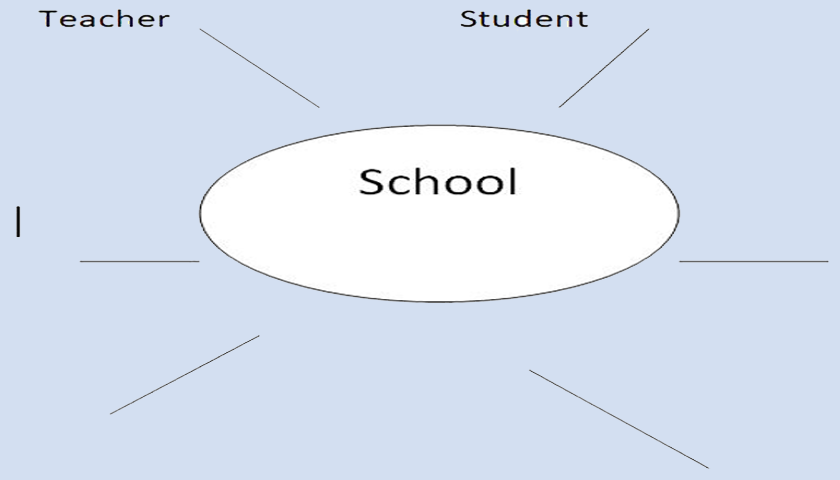
এ ছাড়াও শিক্ষক cat কথাটি বোর্ডে লিখবেন। এবার তিনটি অক্ষর দিয়ে পৃথক পৃথকভাবে একটি noun, একটি verb একটি adjective শব্দ তৈরি করতে বলবেন। এ ক্ষেত্রে শিক্ষক সরাসরি শিক্ষার্থীদের সাহায্য করবেন।
আর একটি পদ্ধতি আছে যাকে বলে Antakshari. চেইন ড্রিলের মাধ্যমে শিক্ষক এই প্র্যাকটিসটি করাতে পারেন। এতে শিক্ষার্থীরা দুই দলে বিভক্ত হয়ে যাবে অথবা যার যার সিটে বসে থাকবে। ধরা যাক, একজন শিক্ষার্থী sell শব্দটি উচ্চারণ করল। এই শব্দটির শেষ অক্ষর l, L দ্বারা অন্য আর একজন শিক্ষার্থী নতুন আর একটি শব্দ বানাবে। এভাবে দেখা যাবে সমস্ত শিক্ষার্থী এই প্র্যাকটিসে অংশগ্রহণ করছে এবং ক্লাস হয়ে উঠেছে প্রাণবন্ত। শিক্ষকও ক্লাসে আনন্দ পাবেন তাকে আর অধৈর্য হয়ে ক্লাসে বসে থাকা বা ক্লাস কীভাবে নিয়ন্ত্রণ করবেন এ ব্যাপার নিয়ে চিন্তা করতে হবে না।
ছাত্রছাত্রী কিংবা যে কেউ ইংরেজি Vocabulary বৃদ্ধি করার জন্য বাসায় কিংবা বন্ধুবান্ধবদের মধ্যে এ ধরনের প্র্যাকটিসগুলো করতে পারেন। বড় ভাই, বোন, বাবা অথবা মা কিংবা বন্ধুদের মধ্যে একজন শিক্ষকের ভূমিকায় অভিনয় করতে পারেন। কোন অবসর সময়ে এ ধরনের প্র্যাকটিস করতে পারেন। অযথা সময় নষ্ট না করে নিজেরা এ ধরনের প্র্যাকটিস করতে পারেন তাহলে একদিকে আপনার Vocabulary উন্নত হবে, সময়টি ভালোভাবে কেটে যাবে এবং আপনার কথা বলার সাহস ও দক্ষতা বেড়ে যাবে
Vocabulary শেখানোর নিম্নলিখিত পদ্ধতিগুলো শিক্ষক বা অভিভাবক ব্যবহার করতে পারেন:
১. সংজ্ঞা বা ব্যাখ্যা দেয়া বা করা। (Definition/Explanation) ইংরেজিতে এমন কিছু শব্দ আছে যেগুলোর অর্থ বোঝানোর জন্য বা বুঝার জন্য শিক্ষককে Definition/Explanation দিতে হবে এবং শিক্ষার্থীকে অক্সফোর্ড ডিকশনারি থেকে Definition/Explanation পড়তে হবে। মনে রাখতে হবে ইংরেজি শেখার জন্য অবশ্যই ইংলিশ টু ইংলিশ ডিকশনারি ব্যবহার করতে হবে। কারণ সেখানে শব্দের সঠিক ব্যাখ্যা এবং বাক্য তৈরি করে উক্ত শব্দের ব্যবহার দেখানো হয়েছে। একটি শব্দের শুধু বাংলা অর্থ জানলেই হবে না আর সব সময় সব শব্দের সঠিক বাংলা করাও যায় না। ফলে ভাষাগত একটি ব্যবধান থেকে যায়। এজন্য ইংলিশ টু ইংলিশ ডিকশনারি ব্যবহার করতে হবে শিক্ষার্থীদের। শিক্ষকদের তো বটেই।
২. অনুবাদ (Translation)-আবার কিছু কিছু শব্দ আছে যেগুলো অনুবাদের মাধ্যমে সহজেই বোঝানো যায় এবং বুঝা যায়। এ ক্ষেত্রে ইংলিশ টু বেঙ্গলি ডিকশনারি ব্যবহার করা যেতে পারে ব্যক্তিগতভাবে শেখার ক্ষেত্রে এবং শেখানোর ক্ষেত্রে শিক্ষক অনুবাদ করে দিতে পারেন। তবে সব সময় ইংলিশ টু ইংলিশ ডিকশনারি ব্যবহার করাই ভালো।
৩. বাস্তব চিত্র বা চার্ট বা ছবি প্রদর্শন (Realia-Using real objects/showing chart/pictures)- Vocabulary শেখানোর ক্ষেত্রে এটি সবচেয়ে কার্যকরী পদক্ষেপ। কারণ visualization এর মাধ্যমে যে শিক্ষা অর্জন করা হয় তা দীর্ঘস্থায়ী। যেমন, আমরা তিন ঘণ্টা একটি সিনেমা দেখে তার পুরো ঘটনা অনেকদিন মনে রাখতে পারি। তার কারণ, আমরা ঘটনাটি visualize করেছি। অথচ একটি নভেল পড়ে আমরা সব ঘটনা অতটা মনে রাখতে বা ধরে রাখতে পারি না। কাজেই যতটা বা যতগুলো সম্ভব আমরা ছবি বা বাস্তব ছবি বা চার্ট ব্যবহারের মাধ্যমে শিক্ষার্থীদেরকে Vocabulary শেখাবো এবং শিখব।
৪. মুখম-লের প্রকাশ বা ভাবভঙ্গি (Facial expression/Gestures)—কিছু কিছু শব্দ যেমন- anger, somber, grave, gravity ইত্যাদি আমরা Facial expression/Gestures এর মাধ্যমে শিক্ষার্থীদের বুঝাতে পারি। ইংরেজি ডিকশনারিতেও এসব শব্দের প্রকাশ ছবির মাধ্যমে দেখানো হয়েছে।
৫. সমার্থক বা বিপরীতার্থক শব্দ দিয়ে (Antonym/Synonym)—আবার কিছু কিছু শব্দ যেগুলো শিক্ষার্থীদের ইতোমধ্যে জানা, এ শব্দগুলোর বিপরীত বা সমার্থক শব্দ বলে দিলে শিক্ষার্থীরা সহজেই আত্মস্থ করবে পারবে।
৬. প্রসঙ্গ থেকে বা অনুমান করে Vocabulary শেখানো বা শেখা হয় (Inferring/ guessing meaning from the context) আমরা কোনো আর্টিকেল বা বিষয় পড়তে গিয়ে অনেক শব্দের সরাসরি অর্থ জানি না, অথচ উক্ত বিষয়টি আমরা বুঝতে পারি। অর্থাৎ অনেক শব্দের অর্থই আমরা অনুমান করে নেই বা context (প্রসঙ্গ) থেকে বুঝতে পারি। এসব ক্ষেত্রে তৎক্ষনাৎ কোনো ডিকশনারি দেখা হয়নি বা কোনো শিক্ষকের সাহায্য ছাড়াই আমরা অর্থ বুঝে ফেলেছি। Vocabulary শেখানোর সময়ও আমরা একটি বাক্য লিখে সেখানে এমন একটি শব্দ ব্যবহার করব যার অর্থ শিক্ষার্থী বাক্যটি পড়েই বুঝতে পারবে। আলাদা ব্যাখ্যা করার প্রয়োজন হবে না।
৭. মুকাভিনয় বা অ্যাকটিং এর মাধ্যমে (Miming/Acting)—মাধ্যমে আমরা অনেক শব্দের অর্থ শিক্ষার্থীদের বোঝাতে পারি।
৮. প্রদর্শন বা ডিমনেস্ট্রশনের মাধ্যমে (Demonstration-announcement, procession, Queue) যেমন কোনো কিছু ঘোষণা করা, লাইনে দাঁড়ানো, বক্তৃতা দেয়া ইত্যাদি আমরা Demonstration এর মাধ্যমে দেখাতে পারি। এভাবে দেখাতে পারলে শিক্ষার্থীদের মনে দাগ কেটে থাকবে।
উপরোক্ত বিষয়গুলো আমরা সহজে এভাবে বলতে পারি-
কোনো কোনো শব্দের অর্থ বোঝানোর জন্য সংজ্ঞা বা ব্যাখ্যা দেয়া প্রয়োজন। অনুবাদের মাধ্যমে আমরা অনেক শব্দের অর্থ ছাত্রছাত্রীদের বুঝিয়ে দিতে পারি। Dictionary এর সাহায্যে আমরা অনুবাদের মাধ্যমে শব্দের অর্থ বুঝতে পারি। বাস্তব চিত্র প্রদর্শন করে, ছবি দেখিয়ে বা চার্ট দেখিয়ে আমরা শব্দের অর্থ বুঝিয়ে দিতে পারি। যতগুলো সম্ভব বাস্তব বস্তু প্রদর্শনের মাধ্যমে আমরা ক্লাসে ছাত্রছাত্রীদের বুঝিয়ে দিতে পারি। প্লেনকে আমরা হাতের মুঠোয় এনে দেখাতে পারব না তবে একটি কলম হাতে নিয়ে প্লেনের মতো করে দেখাতে পারি। কিছু কিছু শব্দ যেমন- রাগ, ক্রোধ, খুশি হওয়া ইত্যাদি Facial expression/Gestures এর মাধ্যমে প্রকাশ করতে পারি। কিছু কিছু শব্দ বিপরীত বা সমার্থক শব্দ ব্যবহার করে শেখাতে পারি যা ইতোমধ্যে বলা হয়েছে। মুকাভিনয় এবং অ্যাকটিংয়ের মাধ্যমেও আমরা শব্দের অর্থ বোঝাতে পারি। ডিমনেস্ট্রশনের মাধ্যমে আমরা শব্দের অর্থ শেখাতে পারি। যেমন কোনো কিছু ঘোষণা করা, লাইনে দাঁড়ানো এবং মিছিলে অংশগ্রহণ করা ইত্যাদি।
আপনি নতুন শব্দ এবং শব্দের ব্যবহার জানার জন্য ইংরেজি দৈনিক পত্রিকা নিয়মিত পড়বেন। ইংরেজি পত্রিকা কেন? কারণ আমরা খবরাখবর জানার জন্য প্রতিদিন সংবাদপত্র পড়ি। অনেক শব্দ হয়ত বুঝবে না, কিন্তু প্রসঙ্গ থেকে অনেক শব্দই বুঝতে পারবেন। শব্দ বুঝতে না পাড়লে বিরক্ত হবেন না বা পড়া বন্ধ করে দিবেন না বা বার বার ডিকশনারি খুঁজবেন না, পড়া চালিয়ে যাবেন। কারণ পুরো বিষয়টি পড়লে বা আরও দু একটি আর্টিকেল পড়লে অনেক শব্দের অর্থ এবং ব্যবহার আপনি ওখান থেকেই বুঝতে পারবেন। সব সময় মনে রাখতে হবে শব্দ ব্যবহার করতে পারাটাই হচ্ছে আপনার টার্গেট এবং সার্থকতা। আর vocabulary শেখা মানেও কিন্তু তাই, শুধু শব্দের অর্থ জানা মানে vocabulary শেখা নয়। Longman Dictionary তে বলা আছে Reading is one of the best ways of improving your vocabulary.
মনে রাখবেন আপনি যে সব শব্দের শুধু অর্থ জানেন কিন্তু শব্দগুলো ব্যবহার করেন না এই বিষয়টি passive vocabulary নামে পরিচিত। আর যে শব্দের আপনি অর্থও জানেন এবং ব্যবহারও জানেন সে বিষয়টি active vocabular নামে পরিচিত। এবার আমরা জামিল সাহেব এবং হাসিব সাহেবের মধ্যে কথোপকথনটি শুনি।
Jamil: Hasib , how do you teach vocabulary to your students?
Hasib: Why? I tell them the Bengali meaning of the words which students don’t understand
Jamil: It’s okay but there are some other ways to teach vocabulary to the students.
Hasib: Is it? Please tell me something about them.
Jamil: Sure. Suppose, you want to teach your students many words about school. In this case, you can put the students into groups. Tell the groups to make as many words as they can write about school (e.g. blackboard, classroom) . Give them ten minutes time. Now tell them that the group which can make the largest number of words will be declared winner .
Hasib: It must be an effective way. It creates a kind of competition among the students to produce more words and they will start doing the work with double interest. Young students’ brain is usually fertile. If their brain is not utilized, they will remain busy with doing other things. So, I think it’s a good initiative to engage the students.
Jamil: Now collect the scripts. Then invite one or two representatives from each group to read the words they have written. Many words will be seen ‘common’ while some may be ‘uncommon’. What benefits you think they will get through this exercise?
Hasib: The uncommon words will also be known to all.
Jamil: Exactly. There may be some hard words which you can write on the board.
Jamil: Now tell the students to make sentences with the words they have written. They can do it in the group as well. Fix up a time. Collect the scripts after a certain time. Invite another representative to read out the sentences they have prepared.
Hasib: But many students will write many wrong sentences.
Jamil: Definitively. But it doesn’t matter. Here is the work of a teacher. Teacher will make the wrong sentences correct without mentioning the name who have made mistakes.
Hasib: It will be beneficial to the students because they will not have to memorize paragraph or easy. Many students do that even these topics are known to them.
Jamil: This practice can be done by the people of the same age to develop their vocabularies. Can you tell me Hasib what are the benefits of putting the students into groups?
Hasib: I think students’ active participation in the class is essential. Many slow learners don’t want to participate in any activity of the class. When they are in the group, they cannot but participate in also.
Jamil: Yes, Hasib, you’re right. If the teacher speaks all the time in the class, students will lose interest.
Hasib: I have seen it in my class also.
Jamil: You can use the following spider gram to develop vocabulary of the pupils as well in your vocabulary teaching class.
Hasib: How shall I do that?
Jamil: You see how it is done. Write the word ‘school’ and elicit the words related to school from the students.
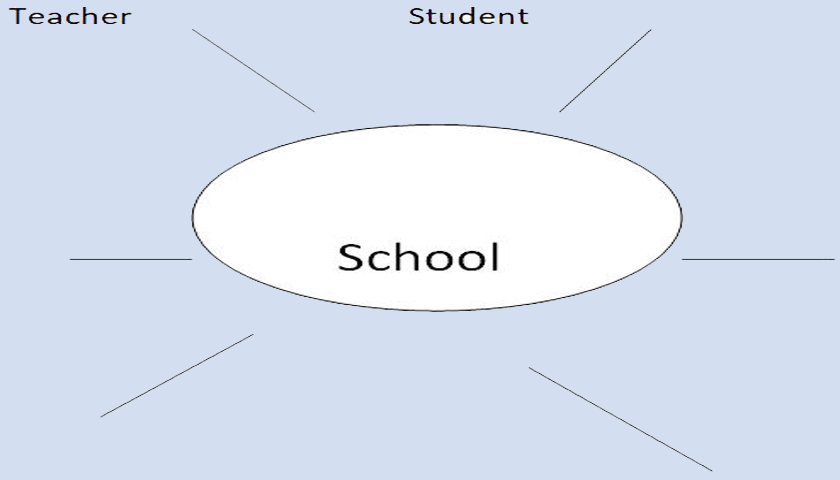
Hasib: Excellent. I will definitely practice it in my class.
Jamil: I am giving you another technique which might be interesting as well in vocabulary teaching class. Write the word ‘cat’ on the board. Now tell the students to write a noun, an adjective and a verb using the separate alphabets.
Hasib: It also seems interesting .
Jamil: You can practice this drill as well. It is known as Antakshari drill.
Hasib: How can I do that?
Jamil: This drill tells to get the students divided into two groups or have their respective seats. One will utter the word’ sell’ as the last alphabet of the word is ‘l’ another one will make a new word which begins with ‘l’.
Hasib: Now I have a question, Mr. Jamil.
Jamil: Yes, go on.
Hasib: When we teach a lesson, passage or do this kind of exercise many new words appear which students don’t understand. If they don’t know the Bengali meaning of those words, their understanding gets hampered. What should I do in that situation?
Jamil: Yes, Mr. Hasib. There are several ways to make the students learn the meaning.
Hasib: Please tell me those techniques.
Jamil: The most effective way to teach vocabulary is ‘realia’
Hasib: Realia? What’s that ?
Jamil: It’s a practical way of showing things. Suppose, students want to know the meaning of mango. In that case, it is better to show them a mango. It is known as regalia. It helps students to remember its meaning for long.
Hasib: But we cannot show all the things.
Jamil: That’s right. Suppose, we want to give the students the meaning of honesty. In that case, without giving them direct Bengali meaning just explain it or give a definition following ‘Oxford’ dictionary.
Hasib: If students want to know the meaning of ‘anger, grave, etc?
Jamil: You just use your facial expression. Show them that now you are angry.
Hasib: Really interesting. This kind of classes must be amusing also.
Jamil: If they want to know the meaning of smile or laugh what will you do?
Hasib: I can laugh and say I am laughing.
Jmail: That’s fine. This is known as miming or acting. Sometimes you can give the meaning through demonstration as well.
Hasib: How is it?
Jamil: Suppose, you need to give them the meaning of ‘announcement’ or ‘queue’. In that case you can demonstrate that you are announcing using a folding paper as mike. You can stand in a queue inviting some students.
Hasib: Great things I am leaning from you Mr. Jamil.
Jamil: Sometimes you can use ‘antonym’ or ‘synonym’ also to give them the meaning. Suppose, they want to know the meaning of ‘worse’. You can say it is opposite of ‘better’.
Hasib: This way is very easy but to speak the truth it was quite unknown to me.
Jamil: It’s not a problem. We learn throughout our life. We learn every day. Sometimes you need not give any kind of explanation or translation or even use any technique we have discussed so far.
Hasib: What should we do in that case?
Jamil: When we read a big passage or a story or something like this, we meet many words whose direct meaning we don’t understand. But we guess their meaning from the context.
Hasib: What’s that?
Jamil: The situation of the story or passage will help you guess the meaning. So, what does it mean?
Hasib: It means we need not see the dictionary always or ask someone to learn the meaning of some particular words.
Jamil: Haven’t you met such kind of situation?
Hasib: Definitely I did. So, what I have understood that we should not tell the students any Bengali meaning directly. Isn’t it?
Jamil: It does not mean that you will never do it. When you see neither of the ways we have discussed can be applied or your students are very slow learners in that case you can translate the meaning.
Hasib: But most of the teachers just translate the meaning of any English word into Bengali.
Jamil: This is not an effective way. It lessens the reasoning faculty of the students. You know, giving the meaning of any word using translation is a weaker and less effective way to teach vocabulary. It should be the last attempt.
Hasib: What’s your general suggestion to develop our vocabularies?
Jamil: I will suggest you to read English newspapers every day.
Hasib: Yes, I do it and advice my students also to do it. But the problem is ---- many words they don’t understand.
Jamil: You need not understand all the meaning of all the words but continue reading. If you continue reading, the subsequent events will help you guess the meaning of many unknown words.
Hasib: From now on I will try to do that.
Jamil: We should remember that learning vocabulary becomes successful when we can use the words in our practical life English. Vocabulary learning does not mean to learn just the meaning of some words.
Hasib: From your discussion I have got the idea that we should learn the use of the words, not just the Bengali meaning of English words.
Jamil: Yes, that should be our target. It is said in the Longman Dictionary that ‘reading is one of the best ways of improving our vocabulary.’
Hasib: So we should read a lot to develop our vocabulary.
Jamil: Right.
Determine whether the following statements are True or False.
(a) It’s a good way to memorize all the English words of a dictionary. (False)
(b) It is better to learn how to use the words than only knowing their meaning. (True)
(c) It is not a good way to give just the Bengali meaning of a word.(True)
(d) It is the best way to use ‘ realia’ to teach vocabulary. (True)
(e) Miming is also an effective way to teach vocabulary. (True)
নিচের অনুশীলনীটি করুন:
B
Fair.
The flower looks beautiful. Everybody likes a beautiful flower.
C
Cunning
The fox is a cunning animal.
I
Sharp
He is a very intelligent boy.
EHSTON
Honest
He is an honest man.
MAFUSO
Famous
‘Postmaster’ is a famous short story of Rabindranath Tagore
চলবে...
লেখক: শিক্ষা বিশেষজ্ঞ ও গবেষক, ব্র্যাক শিক্ষা কর্মসূচিতে কর্মরত।
ইংরেজি কেন শিখব, কীভাবে শিখব ।। ষট্বিংশ পর্ব
ইংরেজি কেন শিখব, কীভাবে শিখব ।। পঞ্চবিংশ পর্ব
ইংরেজি কেন শিখব, কীভাবে শিখব ।। চতুর্বিংশ পর্ব
ইংরেজি কেন শিখব, কীভাবে শিখব ।। ত্রয়োবিংশ পর্ব
ইংরেজি কেন শিখব, কীভাবে শিখব ।। একবিংশ পর্ব
ইংরেজি কেন শিখব, কীভাবে শিখব ।। বিংশ পর্ব
ইংরেজি কেন শিখব, কীভাবে শিখব ।। ঊনবিংশ পর্ব
ইংরেজি কেন শিখব, কীভাবে শিখব ।। অষ্টাদশ পর্ব
ইংরেজি কেন শিখব, কীভাবে শিখব ।। ষোড়শ পর্ব
ইংরেজি কেন শিখব, কীভাবে শিখব || ত্রয়োদশ পর্ব
ইংরেজি কেন শিখব, কীভাবে শিখব ।। দ্বাদশ পর্ব
ইংরেজি কেন শিখব, কীভাবে শিখব ।। একাদশ পর্ব
ইংরেজি কেন শিখব কীভাবে শিখব ।। দশম পর্ব
ইংরেজি কেন শিখব কীভাবে শিখব ।। নবম পর্ব
ইংরেজি কেন শিখব কীভাবে শিখব ।। অষ্টম পর্ব
ইংরেজি কেন শিখব কীভাবে শিখব ।। সপ্তম পর্ব
ইংরেজি কেন শিখব কীভাবে শিখব ।। ষষ্ঠ পর্ব
ইংরেজি কেন শিখব কীভাবে শিখব ।। পঞ্চম পর্ব
ইংরেজি কেন শিখব কীভাবে শিখব ।। চতুর্থ পর্ব
ইংরেজি কেন শিখব কীভাবে শিখব ।। তৃতীয় পর্ব
